
 Jeff Sundin Fishing Report October 31, 2019 "Freezing the Freeze-Able"
Jeff Sundin Fishing Report October 31, 2019 "Freezing the Freeze-Able"
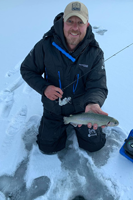 Without a doubt, this is the earliest point in any season that I’ve seen pictures of anyone already ice fishing. But an acquaintance, Craig Oyler was actually on the ice in South Dakota, catching fish yesterday.
Without a doubt, this is the earliest point in any season that I’ve seen pictures of anyone already ice fishing. But an acquaintance, Craig Oyler was actually on the ice in South Dakota, catching fish yesterday.
Closer to home, my own reconnaissance didn’t produce any news as dramatic as that. But I did see signs of an early ice fishing season headed our way.
Most if not all of the small, isolated ponds were already frozen over on Wednesday morning. Some of the smaller, shallow water lakes had ice forming along their shorelines as well. And by yesterday evening, images of ice forming around the edges of Upper Red Lake had begun showing up on the internet.
Obviously, it’s a little bit early to get too worked up about finding a spot to ice fish. But it is definitely NOT too early to begin preparing for it. So after I returned home on Wednesday, I started checking my inventory of ice fishing lures, ice line and fishing rods. Today, I'll be rounding up everything I need to be ready for the first trip.
Last year I promised myself that I'd begin this new season with an electric ice auger. So today, I’m gonna keep that promise and order myself an electric auger. Looking at the forecast, I wouldn’t be surprised if there’s a place to use it shortly after it arrives. . ![]() — Jeff Sundin 218-245-9858 or EMAIL
— Jeff Sundin 218-245-9858 or EMAIL
 Jeff Sundin Fishing Report October 28, 2019 "Wishing It Would Never End"
Jeff Sundin Fishing Report October 28, 2019 "Wishing It Would Never End"
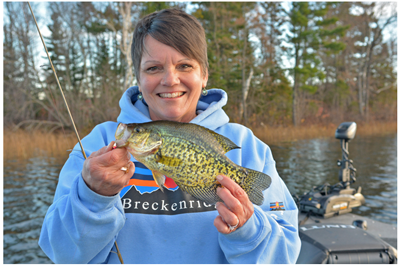 So far I haven't been disappointed in my decision to trust the weather forecast. Its 28 degrees right now, heading for a high of 35 and it's not gonna get much warmer than that any day this week. So I guess that makes me feel pretty good about getting the boat put away for the winter.
So far I haven't been disappointed in my decision to trust the weather forecast. Its 28 degrees right now, heading for a high of 35 and it's not gonna get much warmer than that any day this week. So I guess that makes me feel pretty good about getting the boat put away for the winter.
The decision has been made easier since I and the Hippie Chick got to wrap the season up with a nice day on Saturday.
I can tell you that for her, that one nice day was hard earned and well deserved. Over the past few months, the weather has done nothing but work against the two of us. It’s been cold, windy and sometimes wet every time we’ve had a chance to fish together. She could have bailed out on any of them, but she never did.
Throughout the fall, I was on a mission to discover fresh territory and checking out “new lakes” isn’t always the best way to catch a lot of fish. She knew that, but never wanted me to go suffer those blustery days alone, instead she came along and endured whatever crummy weather Mother Nature deemed necessary to dish out.
She did have one stipulation on Saturday though; “I’ve spent enough time exploring, this time I want to catch fish.” A discussion ensued; we tossed around a few ideas and then came up with a plan. I decided to take her down to the lake where I fished with the Muellers a few weeks ago. That was a fun day and it was productive too, maybe I could replicate that one for the two of us.
The lake’s shoreline looked a lot different this time than in did on my last visit. The trees were leafless and the woods were colorless, at least for the most part. The water temperature was 45 degrees, not much different than the air temperature.
You've already known for a while that panfish have moved out into open water, so there's real no new news to share about location. For that matter, there isn't any hot new tips to share about any part of the actual fishing. Just scroll down this page for all of the facts about fish location and presentations, none of it has changed.
We motored around the lake a little bit, located a school of panfish, lowered the Terrova into the water and hit the spot lock. I rigged Susan up with a Tungsten Bug and tipped it with a wax worm; she dropped it over the side and caught a fish.
Every so often, I made a little move to be sure that the boat was located over some fish. After that there wasn’t much else to do except watch my wife reel in some. I can usually tell when she’s having fun because of her giggle, but this time I really really knew because she said; “now this is fun Jeffrey.” That was definitely a positive signal and plainly good enough to satisfy me that the trip was a success!
When I asked her what she would use for a title on this report, she said; “Wishing It Would Never End”. Yeah, I guess that is a fitting title and I think we both feel the same way; the open water season is ending way too soon this year.
But getting back to that weather forecast, we do have more fishing to look forward to. It doesn’t look like we’ll have long to wait long either, small ponds and shallow shorelines should begin to freeze this week. Unless there’s a major, unexpected warm up on its way, I’ll bet we’ll be hearing about ice forming on shallow lakes before the St. Paul Ice Fishing Show.
So for me, today marks the un-official beginning of Ice Watch 2019 and I’ll be around to keep you in the loop as developments develop. ![]() — Jeff Sundin 218-245-9858 or EMAIL
— Jeff Sundin 218-245-9858 or EMAIL
 Jeff Sundin Fishing Report October 25, 2019 "Producing The Produce-Able"
Jeff Sundin Fishing Report October 25, 2019 "Producing The Produce-Able"
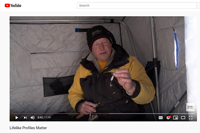 There are more than a few sad anglers out there, the ones who have their boats put away for winter and have no plans to fish again until the 2020 season opener. But for every sad one, there’s also a happy one. They’re happy because for them, the ice fishing season is just around the corner.
There are more than a few sad anglers out there, the ones who have their boats put away for winter and have no plans to fish again until the 2020 season opener. But for every sad one, there’s also a happy one. They’re happy because for them, the ice fishing season is just around the corner.
I’m lucky; I get to fish all summer and all winter, so I’ve always got something to look forward to, the next season is always just around the corner. Even while my boat is still hooked up to the truck, I’ve already started organizing the ice fishing gear for an ice season that will be upon us in short order.
Throughout the guiding season, I’m frequently asked about what I do in the winter time. Writing, photography, producing web content and videos is what keeps me busy during the hard water season. I’ve noticed that the folks at Lindy have begun publishing some of the work that we produced last winter. So if you’ve been curious, here’s a sample of what “going to the office” looks like for me during the winter. >> Ice Fishing Lures: "Lifelike Profiles Matter"
See More >> Current Fishing Reports ![]() — Jeff Sundin 218-245-9858 or EMAIL
— Jeff Sundin 218-245-9858 or EMAIL
Minnesota's Quality Bluegill Initiative Updates and Progress Reports October 25, 2019
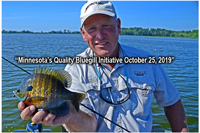 I love fishing for sunfish, I could do it every day and never miss fishing for any other species. You may not be that passionate about them, but whether you spend a lot of time fishing for sunfish, or rarely do it at all, I’ll bet we still have something in common.
I love fishing for sunfish, I could do it every day and never miss fishing for any other species. You may not be that passionate about them, but whether you spend a lot of time fishing for sunfish, or rarely do it at all, I’ll bet we still have something in common.
Whenever either one of us does fish for sunfish, we’d like them to be big ones!
Minnesota’s Quality Bluegill Initiative probably hasn’t been on your mind lately, in fact you may not have even known that there was one. But it’s been on mine and I was just beginning to wonder when I’d hear some fresh news about how it’s progressing.
Just yesterday, I ..." Read >> Minnesota's Quality Bluegill Initiative October 25, 2019
 October 23, 2019 — "Releasing Crappies Caught In Deep Water"
October 23, 2019 — "Releasing Crappies Caught In Deep Water"
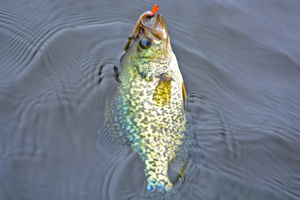 Loren Bosmans wrote; “Jeff, (I) love reading your fishing reports and read with interest your comments regarding barotrauma to crappies brought up from deep water.
Loren Bosmans wrote; “Jeff, (I) love reading your fishing reports and read with interest your comments regarding barotrauma to crappies brought up from deep water.
My friend Craig Bowron and I do a lot of fall fishing for crappies in deep water. Last week we noted the crappie’s jaw/mouth is virtually “locked” open when getting to surface from deep water.
We found that by lifting up gently on the jaw and holding the mouth closed for maybe 5 seconds before returning to the water resulted in the vast majority of the crappies swimming off rapidly for the depths and not floating stunned on the surface. Try it and let me know what you think.”
Thanks for the tip Loren; I applaud the fact that you two have done some thinking about barotrauma. The fact that you’ve cared enough to come up with ways to help mitigate part of the risk to the fish is admirable.
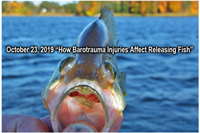 To be sure, fish that swim away quickly after being released do definitely have a “better” chance of survival than the ones that don’t. Unfortunately though, injury to fish caused by yanking them up from the depths is not limited only to the expanding swim bladder. There are lots of fish that swim away, apparently healthy, that die later because of injuries caused during their trip to the lake’s surface.
To be sure, fish that swim away quickly after being released do definitely have a “better” chance of survival than the ones that don’t. Unfortunately though, injury to fish caused by yanking them up from the depths is not limited only to the expanding swim bladder. There are lots of fish that swim away, apparently healthy, that die later because of injuries caused during their trip to the lake’s surface.
Barotrauma is a big subject to tackle, in fact it’s too big to try and cram into this report. It should really be addressed in a book, as a stand-alone topic. But, your comments, along with others, have given me incentive to try taking the subject on in the most meaningful way I can.
The article isn’t perfect because during my research, I’ve learned that there are wide gaps in the data that’s available. Even though the subject of barotrauma has been on a lot of people’s minds, studies, particularly ones focusing on crappie, walleye and panfish are hard to track down.
That said, I’ve contacted a variety of fish biologists and there are enough facts out there to at least get the project started. I will provide updates periodically as more facts they become available. Follow this link to the article >> The Effects Barotrauma on Released Fish October 23, 2019
 Greg Clusiau, "Greg's Guide Lines" October 22, 2019 "Clusiau Bids Farewell To Readers"
Greg Clusiau, "Greg's Guide Lines" October 22, 2019 "Clusiau Bids Farewell To Readers"
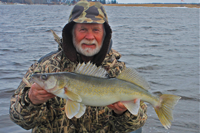 "Well, it’s been a good ride and by that, I mean writing a weekly outdoors column for over 30 years. For that length of time, I’ve had a Monday-by-noon deadline continually hanging over my head. I wondered many times, how I was able to pull it off, especially when it was basically a hobby.
"Well, it’s been a good ride and by that, I mean writing a weekly outdoors column for over 30 years. For that length of time, I’ve had a Monday-by-noon deadline continually hanging over my head. I wondered many times, how I was able to pull it off, especially when it was basically a hobby.
Don’t get me wrong, as I thoroughly enjoyed it. It was a lot of fun, writing about countless fishing trips and meeting some of the best anglers in the business.
I think my first ever article was for the Hibbing Tribune, when I wrote about walleye fishing wizard Tom Howell. Back in the day, Howell was releasing more big walleyes than you could shake a stick at. Many eight-pound fish found their way back into the waters of ..." Read >> October 22, 2010 Clusiau Bids Farewell To Readers
 Lake of the Woods, LOW Tourism October 22, 2019
Lake of the Woods, LOW Tourism October 22, 2019
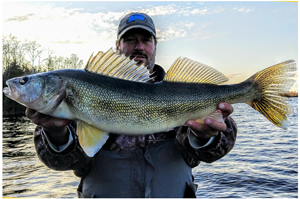 "It's been a fantastic week of fall walleye fishing on the south end of Lake of the Woods. Walleyes in good numbers are being caught all across the south shore. Most popular depths are 14 to 24 feet of water. Anchoring up with a jig with frozen shiner is the ticket. Jig colors in gold, pink, glow, orange or a combo of these colors working well. Along with strong numbers of walleyes and saugers, jumbo perch and pike are being caught in the mix too. There are also walleyes also being caught around Knight and Bridges islands and on structure off of both Long Point and Rocky Point.
"It's been a fantastic week of fall walleye fishing on the south end of Lake of the Woods. Walleyes in good numbers are being caught all across the south shore. Most popular depths are 14 to 24 feet of water. Anchoring up with a jig with frozen shiner is the ticket. Jig colors in gold, pink, glow, orange or a combo of these colors working well. Along with strong numbers of walleyes and saugers, jumbo perch and pike are being caught in the mix too. There are also walleyes also being caught around Knight and Bridges islands and on structure off of both Long Point and Rocky Point.
The Rainy River yielded strong reports this past week and through the weekend. Good numbers of walleyes were being vcaught, along with some big walleyes taken. Fish in spots with current breaks from mouth of river to Birchdale. There is still a strong current and fish are congregating in areas with current breaks, often closer to shore, behind points or holes in river. Fishing in depths of 7 to 16 feet will be a good starting point depending upon the spot. Have jigs up to 1.5 oz if in the main channel, lighter jigs in slack water. Many personal best walleyes and sturgeon this week.
Up at the NW Angle, walleyes are in traditional fall spots. Neck down areas, points and mouths of bays continue to hold good fish. Jigging continues to be the go to method. Big black crappie and jumbo perch bite happening also. Traditional fall muskie bite continues strong, lots of fish boated." — Lake of the Woods Tourism, (800) 382-FISH
 Jeff Sundin Fishing Report October 21, 2019 "So, Do You Ever Get Tired Of Fishing?"
Jeff Sundin Fishing Report October 21, 2019 "So, Do You Ever Get Tired Of Fishing?"
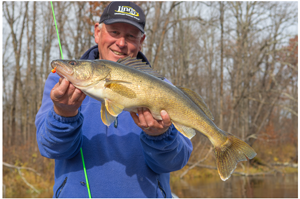 I got a kick out of a question from my friend Jim Jurvelin yesterday.
I got a kick out of a question from my friend Jim Jurvelin yesterday.
At the time, we were floating down the river, having a relaxing afternoon when he said; “I know a lot of folks must ask you this, but do you ever get tired of fishing?”
I grinned when I gave him my answer, “Well Jim, I just finished working every single day for a stretch of 6 weeks, if I got tired of fishing, I could have just stayed home today instead of fishing with you.” We chuckled about that for a minute because the question was sort of an open invitation for my wise crack answer.
Seriously though, it was the truth and it’s easy for me to say no, I don’t get tired of fishing and I don’t think I ever will. It can never get boring because there’s too much to learn.
Take yesterday for example, the reason Jim and I were fishing was that I wanted to test out a “new” lake. Jim was interested in that, plus he wanted to show me a few tricks of his own about walleye fishing on the river.
We arrived at the lake, launched the boat and started the search for something to do. After almost 2 hours of cruising around the lake, I still hadn’t found my first serious sign of anything cool to do. I’d already looked at a lot of the most obviously places and knew that it was time to get more creative. Unfortunately, our reconnaissance got cut short just then because the power wire to my graph shorted out, rendering it temporarily useless.
Because of losing my electronics before we made contact with the fish, our position on learning curve about the “new” lake remains pretty low. So there's one reason not to be tired of fishing already, just imagine how interesting our "off season" will be. We’ll be coming up with theories and formulas to solve the mystery of where those fish were; it’ll keep us busy all winter long.
Admittedly, having the graph turned on and functioning would have been nice, But in a way, the shorted wire was a blessing because it made our next decision easy. If you’re gonna spend the afternoon fishing without your electronics, fishing on a river is probably the best place to go. On a river, especially a small one, you can see a lot of the best “structure” with your eyes. And because the banks are filled with landmarks, there’s little need for a GPS to keep track of favorite spots.
Luckily, fishing the river was already on our agenda anyway, so all we had to do was move up the time frame a little. We’d still be in the game, fishing the old fashioned way, using eyesight and instinct.
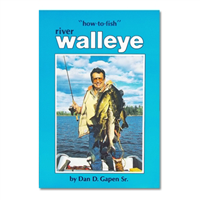 When we arrived, the water level on the river was high. In certain places the current was swift, but overall, it was manageable. I was able to maintain contact with the bottom easily using a 3/8 ounce Lindy Jig. Jim’s jig was of similar size, but may have even been a little bit lighter, a ¼ ounce perhaps.
When we arrived, the water level on the river was high. In certain places the current was swift, but overall, it was manageable. I was able to maintain contact with the bottom easily using a 3/8 ounce Lindy Jig. Jim’s jig was of similar size, but may have even been a little bit lighter, a ¼ ounce perhaps.
Now my version of the fishing report from yesterday will get you in the ballpark. But if you've been interested in river fishing and haven't tried it, then you can really learn a lot more about fishing rivers by picking up one of Dan Gapen’s books.
During my formative years, I used to talk with Dan at the sports shows. Whenever I’d ask a question, he would direct me to the book which contained the correct answer. Both “How to Fish River Walleyes” and “Big River Fishin’” were particularly helpful, but there are more Gapen books to choose from. Follow the link to his website to learn more >> Dan Gapen Books
At first glance, you might be tempted to disregard those books as being outdated. But everything that I ever learned about fishing a river came straight out of those books and the information is still useful today. Those books were written before we had all this fancy gadgetry to rely on, so I think the knowledge I gained from them came in particularly handy on the river yesterday.
Long story short, we did find fish, most of them were too small to be of interest. But there were some close calls with larger ones, and there was this one exceptional fish, this big fat 28 incher.
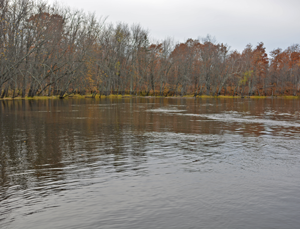 The place where we caught the largest number of small fish was on the upper edge of hole, located on a corner. The depth in the center of the hole was somewhere around 20 feet and the fish were holding on the up-river edge, shallower, maybe at about 10 feet. This scenario is a very common one on small rivers, just think of the hole as a separated little lake. Fish around the edges as if you’re working “the shoreline”, try a variety of positions until you’re satisfied that you’ve worked it over thoroughly.
The place where we caught the largest number of small fish was on the upper edge of hole, located on a corner. The depth in the center of the hole was somewhere around 20 feet and the fish were holding on the up-river edge, shallower, maybe at about 10 feet. This scenario is a very common one on small rivers, just think of the hole as a separated little lake. Fish around the edges as if you’re working “the shoreline”, try a variety of positions until you’re satisfied that you’ve worked it over thoroughly.
The location where we caught a smaller number of larger fish was along a current seam. Places like these are formed by shoreline points or objects that stop the free flow of water in a given area. The fish like to hold along the edge where slack water and river current meet. It’s the area where the current flow is slower than the main river, but not completely still either.
When you’re in the sweet spot, you can feel it, your boat will still be drifting, but at a slower, more manageable pace than it does in the main channel.
Look at the accompanying photo, there’s an area of smooth looking water close to the shoreline and the water in the middle of the river looks turbulent. But do you see that edge where the calm water meets the faster moving water? That’s the seam, that’s where feeding fish often go and it’s my favorite place to try catching them.
Don’t worry if you’re having trouble seeing the seam, I edited the photo as to show exactly where the fish were holding and all you have to do is click here to view >> Walleye Location Along River Current Seam
River fish are used to ambushing baitfish, so they tend to strike harder than fish in a lake do. because of that, we usually don't have to add a lot of action to the presentation. Find a current break, drop the jig and minnow over the side and hold it a few inches above the bottom. When the walleye strikes, it will be tempting to set the hook fast, but remember to give them some time to finish off the minnow and get the jig into their mouth. You'll have a lot better luck getting good hook sets that way.
That sort of wraps it up, we didn't travel too far and we didn't use a very complex presentation either. While I’ve had days on the water that went better, I wouldn’t have traded this one for the world. We spent a nice warm afternoon floating along on a gorgeous stretch of river. We both moved up the learning curve a notch or two and we even caught a few fish to boot.
How could anybody ever get tired of that? ![]() — Jeff Sundin 218-245-9858 or EMAIL
— Jeff Sundin 218-245-9858 or EMAIL
 Wired2Fish October 2019 "StrikeMaster Lithium 40v Ice Auger Review"
Wired2Fish October 2019 "StrikeMaster Lithium 40v Ice Auger Review"
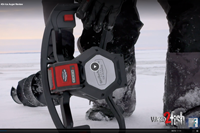 "The ice fishing industry is undergoing a power transformation with new-age lithium-ion battery-powered ice augers coming on the scene with value and performance that has many questioning the viability of gas-powered models.
"The ice fishing industry is undergoing a power transformation with new-age lithium-ion battery-powered ice augers coming on the scene with value and performance that has many questioning the viability of gas-powered models.
Renowned Mille Lacs Lake fishing guide Tony Roach shares his opinion of the StrikeMaster Lithium 40v ice auger after two years of guide punishment. Few drill as many holes as Roach, who's known for keeping customers on fish by "ice trolling" (non-stop moving) upward of 90 days annually.
He discusses durability, cutting speed, the weight factor, battery longevity and why quiet electric power is a big deal on ice." View Video and Learn More >> StrikeMaster Lithium 40v Ice Auger Review
 Jeff Sundin Fishing Report October 20, 2019 "Prodigious Pods of Pot-Bellied Panfish!"
Jeff Sundin Fishing Report October 20, 2019 "Prodigious Pods of Pot-Bellied Panfish!"
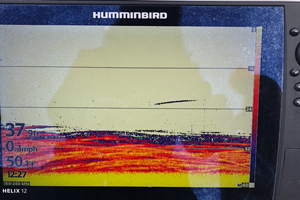 I looked at my calendar and it says that I’m done fishing for the season. In fact, I’ve got the whole next week blocked off, susposedly for a hunting trip. The only problem is that I don’t think I can quit, I’m not ready to be done fishing yet.
I looked at my calendar and it says that I’m done fishing for the season. In fact, I’ve got the whole next week blocked off, susposedly for a hunting trip. The only problem is that I don’t think I can quit, I’m not ready to be done fishing yet.
One reason that it’s hard to give up my fishing rod is that my fishing customers have been so awesome. Not just over the past few weeks, but throughout the entire season. I am truly blessed to have fished with so many wonderful people, folks who have become more than just friends, folks who literally are part of my family.
I thank each and every one of you for riding along in my boat, riding high on "the ups", and sometimes patiently watching me work through "the downs".
AND I can’t say this loudly enough, I don’t do this job for the fish, not for the money either, not even for the love of being outside. It’s you, my friends and family that smiles with me when we do good work and most times, even when we do not. Serving people like you are the reason that I keep fishing; and always will.
The nice weather is partly to blame for my lack of ability to boat the boat into storage too, who wouldn’t want to be out on the lake on days like this?
The fish aren’t helping much either, they’re biting and as you can see by the image of my Humminbird, they’ve been pretty easy to locate. The photo of that giant horde of panfish leads me back to these comments from my report last Thursday.
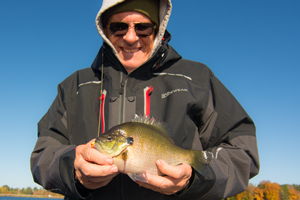 “On Wednesday I discovered that another milestone on the fall panfish migrations had passed. Crappie, sunfish, rock bass and pike were all stacked up, seemingly living together in the same holes. Instead of being segregated into distinctly separate schools of fish, they were co-mingled and because of that, we caught numerous species of fish that were un-intended.
“On Wednesday I discovered that another milestone on the fall panfish migrations had passed. Crappie, sunfish, rock bass and pike were all stacked up, seemingly living together in the same holes. Instead of being segregated into distinctly separate schools of fish, they were co-mingled and because of that, we caught numerous species of fish that were un-intended.
For multi-species anglers, it’s a fun time because it offers a chance to add a few extra fillets to the larder. But it does change the way we have to approach each school of fish we locate.”
What I mean by “how we approach each school of panfish” is this, selecting the correct presentations for each school of fish could make a huge difference in the outcome of your fishing trip.
Let’s use the accompanying screen image as an example, almost everyone who’s seen this photo has said something like; “Man, would I love to get over a school of crappies like that.”
The thing is, those are not crappies, nope, they’re bluegills and they were within casting distance of another school of fish that actually were crappies. The two schools of fish actually were separate, but they were located so close together that they seemed to be all one happy family. These episodes of apparent co-mingling happen a lot during the latter part of the fall season.
I learned this lesson a few years back when we were searching for crappies late in the fall. We found a school of what I thought was crappies; we dropped in a jig and minnow and caught a couple nice ones right away. After that, the action stopped and we almost drove away to look for a different batch of fish. But before we left, I tied a Lindy Tungsten Toad on my line, tipped it with a wax worm and voila, a nice fat sunfish on the first drop, followed up by several more after that.
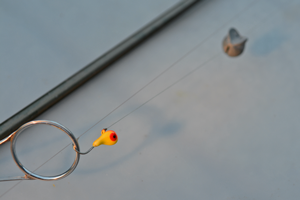 Starting on that day, I made a pact with myself not to ever leave a school of panfish without at least checking to see if alternate presentations produce un-intended results.
Starting on that day, I made a pact with myself not to ever leave a school of panfish without at least checking to see if alternate presentations produce un-intended results.
Last Wednesday, when we fished that school of fish with my standard crappie presentation; a jig tipped with a small fathead and didn’t catch anything. I said to my crew; “Before we get too far away, let’s just try something.” I switched everyone over to Tungsten Toads, added some wax worms and before you know it, we were all catching sunfish.
If we wouldn’t have experimented with presentations, then we would have made the assumption that those fish just weren’t biting. Then we would have completely missed out on the fabulous sunfish that were there.
The interesting thing about Wednesday’s experience is that once we made the switch from minnows to grubs, the only fish we caught were bluegills. The reverse was also true, when we used minnow; crappies were the only panfish that struck. That was unusual, there are almost always a few crappies that will grab the waxies, but it serves as a perfect example to always try both presentations.
One clue that sometimes tips me off that I’m seeing sunfish instead of crappies is the water depth. Sunfish are often located just a little shallower than the crappies are. On Wednesday, most of the crappies were holding at 40 feet, but the school of sunfish was 38 feet deep. The reasons for this may be known only to the fish, but more often than not, I've noted that sunfish do hold closer to the shallower, upper edges of deep holes than do the crappies.
You may notice the huge size of the split shot weight added to the line above the Tungsten Toad. I’ve found that the extra weight really helps my customers get “the feel” of where they’re baits are located in relation to the fish. Those large weights also show up better on my Ice Helix 7, the one I use to allow my crews see where they’re fishing.
By the way, I purposely moved that #2 split shot closer to my lure so that it would show up in the photo. In real life, the split shot is about 18 inches above the Tungsten Toad.
Somebody will ask why I bother using tungsten when I already have such a heavy sinker. The answer is simple; bluegills do not like to see a lot of movement in the water. The extra weight of the tungsten allows my bait to sit still while the fish examine it. This is especially important on breezy days when it’s a struggle to keep the boat from moving around too much.
So the takeaway, I hope, is that you’ll remember to pack in some wax worms and tungsten along with your minnows and jigging whatchamacallits. You might be surprised how often you find yourself with the opportunity to enter “The Bonus Round”. ![]() — Jeff Sundin 218-245-9858 or EMAIL
— Jeff Sundin 218-245-9858 or EMAIL
 Jeff Sundin Fishing Report October 18, 2019 "Fish-ining Up The Season With A Bang!"
Jeff Sundin Fishing Report October 18, 2019 "Fish-ining Up The Season With A Bang!"
 I wrote yesterday that the conditions looked good to give Leech Lake a try and I promised to let you know how my trip over there turned out. Luckily for me, I guessed right this time.
I wrote yesterday that the conditions looked good to give Leech Lake a try and I promised to let you know how my trip over there turned out. Luckily for me, I guessed right this time.
The actual weather turned out to be an exact match of the forecast weather. A southeast breeze produced a light chop on the surface, the drift speed was a perfect .6 MPH, the walleyes were findable and we had enough determination to stick with it until we did, find them.
Like I said yesterday, the walleye bite has been fickle on Leech Lake and recently, I’ve hit the timing wrong, just as often as I’ve hit it right. Our success didn’t come easy; there was a 3 hour search before we had our first strike. We had to keep searching until we found that one sweet spot where the walleyes were gathered.
Early in the morning, we tried some rock spots and also some areas along the steep breaklines on the west side of portage bay. Those weren’t the right places to look yesterday. Once we moved shallower, 8 feet to be exact, then things started happening.
The presentation won’t surprise you, a 1/8 ounce live bait jig tipped with a larger than average minnow. Ours were a mix of rainbows, large fatheads and some other assorted minnows. If there was a color preference, I’d say it was the glow/blue jig that worked the best.
Yesterday evening I was comparing notes with a friend about the bite on Leech. We agreed that the best conditions seem to be when there’s a breeze, but not a raging wind. We both agreed that the fish are showing a preference for weeds over rocks. That’s probably because during fall, a sunny afternoon will draw thousands of shiners, small perch and other baitfish into shallow water.
Conversely, when the wind blows too hard, baitfish either get blown deeper or move deeper on their own. The fish are probably still biting, but they become more scattered and it takes longer to find them. If there happens to be a school of fish near a good rock spot, they can be caught. The problem is that there aren’t that many fish using rocks right now. Except for a handful of the lakes most popular rocky points and bars, rocks have not been the preferred pattern.
You know how big Leech Lake is and you know too that there’s no way that I can know everything that’s going on over there. But from what I’ve observed, the fish are definitely biting; you just have to keep looking until you find the right spot.
Finding the right spot will be easier if you avoid both calm conditions and super windy ones; wait the perfect breeze and you’ll probably do well. Yesterday, the moderate southeast wind was perfect for the west side of Portage Bay. When the wind direction changes, you should reassess where you search. Go to the shoreline that offers the highest probability of success, finding the right conditions will eventually lead to finding catchable fish.
I teased you with this; "For multi-species anglers, it’s a fun time because it offers a chance to add a few extra fillets to the larder. But it does change the way we have to approach each school of fish we locate. I plan on telling you what I mean by that, but I don’t have time this morning, so I’m gonna let you think about it until tomorrow."
I still have news for you about the panfish, but I am again out of time. If you're planning to fish this weekend, especailly for panfish, then take a quick look at the report tomorrow morning, there will be a tip about how to approach deep water panfish. ![]() — Jeff Sundin 218-245-9858 or EMAIL
— Jeff Sundin 218-245-9858 or EMAIL
 Jeff Sundin Fishing Report October 17, 2019 "Quickie Fishing Update"
Jeff Sundin Fishing Report October 17, 2019 "Quickie Fishing Update"
Surface water temperatures now range between 46 and 50 degrees depending on their depth and water clarity.
On Wednesday I discovered that another milestone on the fall panfish migrations had passed. Crappie, sunfish, rock bass and pike were all stacked up, seemingly living together in the same holes. Instead of being segregated into distinctly separate schools of fish, they were co-mingled and we had numerous un-intended catches.
For multi-species anglers, it’s a fun time because it offers a chance to add a few extra fillets to the larder. But it does change the way we have to approach each school of fish we locate.
I plan on telling you what I mean by that, but I don’t have time this morning, so I’m gonna let you think about it until tomorrow.
If you’re thinking walleyes for the weekend, Leech may still be your best bet. One caveat, Leech Lake has been fickle this fall, and depending on how the weather breaks over the weekend, it could be either boom or bust.
The bite has been very wind dependent; too little breeze and the fish don’t show up on the shoreline breaks. Too much wind riles up the lake and seems to blow the fish out of the shallows. But whenever there’s a nice steady chop that facilitates a steady drift, the walleyes start snapping.
The forecast, southeast wind at 5 to 10 MPH looks favorable for today, so I’m going to try it for myself before another big wind blows tomorrow. At the moment, the forecast for Saturday and Sunday are promising, so keep Leech in the back of your mind.
Sorry for the short report today, but it’s an early start today and the clock is ticking, so I gotta run. ![]() — Jeff Sundin 218-245-9858 or EMAIL
— Jeff Sundin 218-245-9858 or EMAIL
 Jeff Sundin Fishing Report October 16, 2019 "Exploring the Explore-Able"
Jeff Sundin Fishing Report October 16, 2019 "Exploring the Explore-Able"
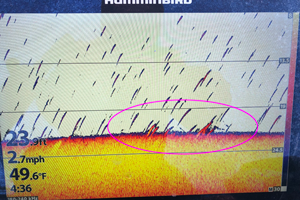 Yesterday I mentioned that I’d be exploring a fresh walleye lake and that I’d have a report this morning.
Yesterday I mentioned that I’d be exploring a fresh walleye lake and that I’d have a report this morning.
Well, I did do some exploring yesterday, but after learning that my customer for today is interested in crappies, I had to shift gears a little bit. Instead of looking for fresh walleye territory, I tried working a couple of crappie lakes. Neither of the lakes was actually “new” to me, but I haven’t visited either for quite a while.
The first lake “used to be” an awesome crappie lake, but has received way more pressure than it can handle. In fact, despite numerous accounts that it was on its last leg, it was still getting a lot of fishing pressure this fall. I really didn’t want to look at this one, but it’s the lake where today’s customer is staying at and I felt obliged to at least have a look.
What I found was single spot, 40 feet deep that was home to a semi-decent looking school of fish. I thought okay, I’ll give it a try, maybe there’s potential to come back tomorrow and harvest 10 fish before we go find something else to do.
My first drop produced an 11 inch crappie, hmm not bad. My 2nd drop produced and 8 inch fish and so did the 3rd drop; both of those were too small to harvest, but both were dead because of being caught in such deep water, so I did. But I decided to stop fishing that spot, the last thing I needed was to wipe out any more of those fish.
I didn’t find much else that interested me, so after looking around for a few hours, I decided to try another lake.
The 2nd lake used to be an awesome fall crappie spot too, but also received a lot more attention than it could handle. I fished it once or twice every fall for a long time, but haven’t fished there since it crashed and burned 4 or 5 years ago. I’ve been watching it since then and nobody else has been fishing it either.
I had my fingers crossed that there might have been a fresh, strong year class since then. I got my wish; it was loaded with crappies again. But except for 2 fish that might have crossed the 9 inch mark, all of them were in the 5 to 7 inch range, way too small to warrant harvest. I set the snooze button on this lake for September 2021 and that’s when I’ll take another look at it.
In the end, I learned a lot yesterday, but not much of the information will be useful for a few years. Until then, it appears that I still have some more exploring to do. ![]() — Jeff Sundin 218-245-9858 or EMAIL
— Jeff Sundin 218-245-9858 or EMAIL
 Jeff Sundin Fishing Report October 15, 2019 "Crappies Take Another Step Toward Winter"
Jeff Sundin Fishing Report October 15, 2019 "Crappies Take Another Step Toward Winter"
 Last weekend’s blast of cold air moved us one step closer to the ice fishing season. Surface water temperatures lingered just above 50 degrees on most Itasca area lakes last Friday and Saturday. By Sunday, there were 48 to 49 degree readings on some of the area’s shallow water lakes.
Last weekend’s blast of cold air moved us one step closer to the ice fishing season. Surface water temperatures lingered just above 50 degrees on most Itasca area lakes last Friday and Saturday. By Sunday, there were 48 to 49 degree readings on some of the area’s shallow water lakes.
Crappies responded by shifting their location closer to traditional early winter haunts. On many lakes, the term “winter locations” means deeper water and in many cases “the deepest” water that’s available. For example, last Friday, we caught most of our crappies in 31 to 32 feet of water. On Monday, there weren’t any fish that same area, instead they had moved out into 40 feet of water and were spread out horizontally across the soft bottom.
Their attitude had shifted into neutral on Monday as well. Crappies that were hitting aggressively before the cold snap were still “catchable” but they were a lot pickier than before. I was lucky that our goal wasn’t too lofty; all we wanted to catch was 10 fish for Craig and catching those 10 wound taking a couple of hours.
By now it’s probably not breaking news, but I still want to share a gentle reminder about what happens when crappies move into and suspend over these deep water holes. They become incredibly susceptible to barotrauma and under these circumstances, catch and release fishing is not feasible.
I am obviously not opposed to harvesting some fish; I just believe that we can do it responsibly. So I fight off certain impulses that come along with finding schools of crappies stacked up over a deep hole. It’s awful tempting to go wild catching fish without thinking about what happens in the future. But honestly, too much lovin’ is the last thing these late fall panfish need.
One of the fish we kept yesterday was small, 9-1/2 inches. But the other 9 were good size and between them all, made up a nice bag. Don’t worry about eating a few smaller fish, just follow your conscious and harvest them instead of allowing them to be wasted.
Once we wrapped up the crappie project, there was another goal. I’d been researching some new walleye lakes and thought that I’d come up with a really good idea. So we loaded up, drained out and drove off to give it a try.
The new lake is a deep one and it reminds me of a smaller version of Cass Lake or maybe certain parts of Walker Bay. There were shallow flats that dropped off quickly into deep, mid lake holes. That worried me a little, but the write up on the DNR Lake Finder was so compelling that I just had to have a look.
When we arrived, the surface temperature over that deep water was 51 degrees, warmer than a lot of shallower lakes in the region. The lake's surface was calm and the sky overhead was mostly cloudy. Those were good conditions for exploring and allowed us to quickly assess most of the juicy looking spots on the map.
In terms of seeing fish on the Humminbird, the exploration was easy. There were numerous locations where we found them holding in 40 to 50 feet of water. Never were any of them willing to strike though, they were just plain not biting.
We fished shallow water and caught some northern pike on the weed edges but didn’t find any other species there.
Even though we didn’t harvest a walleye, I can’t be too disappointed; I didn’t exactly pick the ideal time for experimentation and besides, we did learn a few things. Among those was the validation that the lake does have fish in it. The next time we visit the lake, I’ll have a better understanding about where to start and what to use.
You’d think that a man who runs out of work in a few days would “coast” through them and fish a few of the better-known lakes. But this year I have a bad case of wanderlust, I just feel like I want to squeeze in every new lake I can think of before the snow flies. So today I’m gonna try another new one, maybe it will work out, maybe it won’t; I’ll let you know tomorrow. ![]() — Jeff Sundin 218-245-9858 or EMAIL
— Jeff Sundin 218-245-9858 or EMAIL
 Jeff Sundin Fishing Report October 11, 2019 "Freezing the Freeze-Able"
Jeff Sundin Fishing Report October 11, 2019 "Freezing the Freeze-Able"
I’m looking at the weather forecast and wondering if there’s even any need to bother posting a fishing report this morning.
Forecast temperatures that never climb out of the 30’s are hardly the sort of news that breeds enthusiasm for getting out in a boat. In fact, I can already tell you that my weekend plans have been cancelled. So for me this will be a weekend of preparing for winter, organizing the garage and cleaning boats and who knows what else.
Unless you can access the little back bays without boating long distances, I’d advise you to avoid the large lakes. Forget about fishing on any lake that requires long travel distances is silly, there's too much risk of frezzing something. If you’re bound and determined to fish, stick with the smaller lakes that offer protection from the wind. At least then you can come back to shore for an occasional warm up.
Today, we’re going to try and slip in one more fishing trip before the ship hits the sand. According to the forecast, we've already acheived the high temperature of this day and by the time we wrap up, temperatures will have fallen into the 30's. I’ll post any updates that may be helpful after I see how the weather and water conditions actually unfold later today.
If you’re on your way up, please be careful! ![]() — Jeff Sundin 218-245-9858 or EMAIL
— Jeff Sundin 218-245-9858 or EMAIL
 Wired2Fish October 2019 "Fall Topwater Bass | When and Where to Fish Shallow"
Wired2Fish October 2019 "Fall Topwater Bass | When and Where to Fish Shallow"
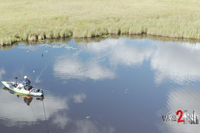 "Cooling fall water temps send baitfish and bass back into the shallows where they put on the feed bag.
"Cooling fall water temps send baitfish and bass back into the shallows where they put on the feed bag.
Kyle Peterson demonstrates the power of topwater walking baits from his kayak for finding and triggering fish during the fall and some key locations to consider.
Peterson's strategy is to cover water quickly with horizontal baits to locate active fish, then make presentation adjustments if necessary.
He shares his unconventional approach to fishing walking baits through hard cover like lily pad stems, bullrushes (aka tulles) and wood. Lastly, he explains why dual hook versions are a better choice than ..." View Video To Learn More >> Fall Topwater Bass When and Where To Fish Shallow
 Jeff Sundin Fishing Report October 10, 2019 "A Perfect Day"
Jeff Sundin Fishing Report October 10, 2019 "A Perfect Day"
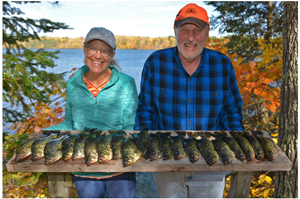 Perfect days don’t come along very often, but every once in a while, they do.
Perfect days don’t come along very often, but every once in a while, they do.
Wednesday was like that for me; 70 degrees outside, sunny blue skies, the crappies were biting and I couldn’t have asked for nicer folks to fish with than the Muellers.
It was supposedly a birthday gift from Mary to Mike, but just between you and me, I think gets a kick out of fishing herself. Anyway, the two of them have a lot of fun together and I think, make a great team.
There isn’t a lot of new information I can share about the fishing because it was all very similar to reports I’ve written over the past few weeks. But there are a few minor developments that vary from recent reports.
The surface water temperature was 52 degrees in the morning; the sunshine brought it back up to 54 degrees by mid-day. It won’t stay there long though; the incoming cold front will take care of that.
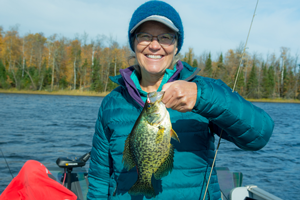 Crappie location had shifted since last week, when I first located these fish last week; they were in 26 to 28 feet of water. Since then, they’d moved deeper and yesterday they were holding tight at about 31 feet.
Crappie location had shifted since last week, when I first located these fish last week; they were in 26 to 28 feet of water. Since then, they’d moved deeper and yesterday they were holding tight at about 31 feet.
Bluegills were not in the mix last week, but yesterday they were. We discovered them incidentally whenever one of them struck a 1/8 ounce Live Bait Jig tipped with a minnow.
I always have a container of wax worms in my pocket, just for occasions like that. So once I saw that bluegill, I rigged up a Lindy Tungsten Fat Boy, tipped it with 2 waxies and dropped it over the side. There were not a huge number of sunfish down there, but there were enough to give me something to do while Mike and Mary were catching crappies.
Catch and release fishing was not an option, because since the fish have moved deeper, the effects of barotrauma were very evident. Luckily, most of the fish were decent quality, ranging from 10 to 11 inches, but there were some 9 to 10 inch fish in the mix too. Yesterday we dealt with that by using the smaller fish for shore lunch and saving the larger ones for the Mueller’s to take home.
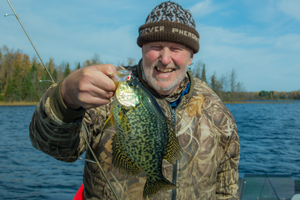 If we wouldn’t have planned the lunch and had my limit to work with, then we would have been forced to save a few fish smaller for their creel. There was no way that we could have released most of them.
If we wouldn’t have planned the lunch and had my limit to work with, then we would have been forced to save a few fish smaller for their creel. There was no way that we could have released most of them.
That brought up an interesting discussion, because like most folks, the Muller’s assumed that if a fish swims away that it is okay. Nothing could be further from the truth though, just because a fish swims away after we yank it up from deep water doesn’t mean that it’s healthy. That’s because much of the damage is internal and can’t be seen by the naked eye.
If you’re interested in knowing more, it’s easy enough to do, just follow the link to the article >> Barotrauma Awareness
Gathering mode went on for a few hours, but eventually we reached the limit and had to switch gears. Northern Pike became the target species because after trying the blackened pike recipe last year, they’d developed a new appreciation for pike as table fare.
The pike fishing was simple; we tied on 1/8 ounce Liny Jigs, tipped them with a golden shiner and drifted along the weed edges. The pike in this lake weren’t exactly attractive; many were both short and skinny. But we did manage to come up with “the right one” to provide another meal of blackened pike.
So that’s how the day went, the stars were aligned perfectly and everything just fell into place. I’m sure that this wasn’t the last “perfect day”, but I look at this weather forecast, and think hmm; it probably was the last one for a while.
Well, it was a good gig while I could get it.
Next up, another panfish trip today, only this time it’s an hour drive in the complete opposite direction. Whatever happens today, I’ll fill you in tomorrow. ![]() — Jeff Sundin 218-245-9858 or EMAIL
— Jeff Sundin 218-245-9858 or EMAIL
 Jeff Sundin Fishing Report October 7, 2019 "Teasing the Tease-Able During the Walleye Wind-Down"
Jeff Sundin Fishing Report October 7, 2019 "Teasing the Tease-Able During the Walleye Wind-Down"
 At 52 degrees, surface water temperatures are within “walleye wind-down” range. We used to refer to this period as the “turnover”. But since receiving my formal education from the Lake Detective a few years back, I know now that lakes that do actually undergo a true turnover are still a long way from experiencing the late fall event. See Article >> Fishing Fall Turnover Walleye
At 52 degrees, surface water temperatures are within “walleye wind-down” range. We used to refer to this period as the “turnover”. But since receiving my formal education from the Lake Detective a few years back, I know now that lakes that do actually undergo a true turnover are still a long way from experiencing the late fall event. See Article >> Fishing Fall Turnover Walleye
For me, the term “walleye wind-down” is a good way of describing the adjustment period between the warm and cold water periods. For now, walleyes will end their displays of aggressive, daytime feeding behavior. They’ll begin foraging for shorter periods of time and more often than not, those periods will occur during the crepuscular periods rather than at midday.
This doesn’t mean that you won’t catch any walleyes during the day, you will. But it’s likely that you’ll have to be both patient and persistent to keep walleyes coming into the boat. OH and lucky too, that comes into the picture with the weather forecast on day you choose to fish.
Take yesterday for example, there was a great chop on the surface, it rained on and off throughout the day and the walleyes bit. If there had been too much sunshine, or not enough wind, I think it would have made the day a lot harder for me.
I used the word bit, because they did, but the strikes we had were very tentative and it was difficult to get good hook-sets.
The best way to describe the strike is that there's a slight sensation of added pressure at the tip of your fishing rod. You can sense the difference bewtween a fish and a snag on the bottom; when the rod tip loads up up steadily and quickly, it's a snag. But when there's a nagging sense of light pressure that comes along with you, then it's a fish.
Most times you can see it easier than you can feel it, the rod tip will move gently up and down. Watch close and you can follow the walleye's movement as it chews its way up the minnow. You'll see your rod tip pop or bump, then it will be steady for a second , then there's another bump, eventually another one ... and so on. The signal to set the hook comes whenever the rod tip is loaded and there are no more pops or bumps, only a sensation of steady pressure. That means that the walleye has finished its meals and it's time for your hook set.
On Sunday, it took heroic displays of patience in order to convert a strike into a catch, but at least the walleyes did provide us with opportunity. So remember that when they tease you, it's okay to tease them back; learn how to play the game of cat and mouse and you'll get more good hook sets. Oh and by the way, some of these fish will drop the bait while your're waiting, that's okay. Just be sure that the first thing you do after a fish lets go of your lure is to immeditaely jig it several times. Most of the fish will come back and try again, sometimes a fish will give it 3 or 4 trys before it gets serious about finishing the job.
Walleye were scattered on Sunday, I found a catchable fish or two at almost every stop. We’d get our best strikes on the first pass, maybe another one or two on the second pass, but after that, it was time to move on.
Key depths varied from spot-to-spot, we caught some fish in 10 feet of water, some in 12 and some in 18 feet. Weedlines were important, but any good point with a little gravel or rock usually held a couple of fish too. In fact we fished at least a dozen spots and all but one of them produced something.
If I’m right about walleye behavior during this winding down period, it means that I’ll be lingering on the lakes at little later in the evening. With the full moon coming soon, I may even talk a customer or two into trying the night bite for a few hours. We’ll see how the weather breaks and take it from there. ![]() — Jeff Sundin 218-245-9858 or EMAIL
— Jeff Sundin 218-245-9858 or EMAIL
 Jeff Sundin Fishing Report October 6, 2019 "Discovering the Discover-Able"
Jeff Sundin Fishing Report October 6, 2019 "Discovering the Discover-Able"
 If your favorite lake isn’t producing for you this fall, it’s not because crappies aren’t biting, it’s probably because the fish are not there; they’re just plain gone.
If your favorite lake isn’t producing for you this fall, it’s not because crappies aren’t biting, it’s probably because the fish are not there; they’re just plain gone.
That’s the conclusion that I’ve come to after searching for specks on a lot of my so called “favorite lakes” this fall.
Don’t read any more of this report unless you’re willing to analyze its contents and consider its true meaning. It is not intended to sound like a complaint; it is written in the spirit of helping folks understand what they’ll need to do if they still want to get in on some good fall crappie fishing this season.
You may be thinking okay Jeff, how did you come up with this brilliant theory?
Well, over the past few weeks, I’ve visited some of my own “favorite” fall crappie fishing lakes. Until only a couple of years ago, some of these lakes would have been considered “no-brainer” selections for reliable fall crappie action. But this fall, many of them have been slower than slow.
At first, I assumed it was because my timing was off, that I had just tried fishing the lakes too soon, before the effects of fall moved crappies into the biting mood. But the longer I waited, the less something happened. While I was waiting for the bite to start, other anglers were posting pictures of good crappie catches. That’s what made me decide to start searching for alternatives to my old reliable fall lakes.
When I started trying “new lakes”, my luck changed, now every time I find fish, they bite. I mean bite with a vengeance, some of the fish have hit so hard that I thought they were northern pike instead of panfish.
 After a rained out charter on Saturday, I had a few hours to kill and wondered if it was an opportunity to prove my theory. So I and the Hippie Chick made one last trip to the ever-reliable and super productive “Crappie Lake”. After spending 3 hours scanning and searching, we couldn’t turn up a single crappie.
After a rained out charter on Saturday, I had a few hours to kill and wondered if it was an opportunity to prove my theory. So I and the Hippie Chick made one last trip to the ever-reliable and super productive “Crappie Lake”. After spending 3 hours scanning and searching, we couldn’t turn up a single crappie.
Another small lake, located just down the road is known for having a handful of crappies in it. But doesn’t get fished very heavily because most fish are small, and they don’t gather in large schools either. In fact you can look at the image of my Humminbird screen and see that there were only about a dozen fish in the school and this was the largest pod of fish I found. Of those dozen, most were small, only a few were nice ones but they all bit and they bit hard.
Over the past week, I’ve fished 4 lakes that I’d call fairly obscure. Sometimes, like yesterday, it’s taken an hour or more to locate a school of fish, but when I have, they have been active. Now I can’t help but see it any other way; crappie bite in some of my favorite lakes isn’t off because of the weather, the fish just aren’t there right now.
It’s easy to point the finger at fishing pressure because it definitely plays a big role. But Mother Nature takes some of the blame too; she doesn’t always provide the right weather for crappies to spawn. There are years when they never produce any offspring at all and to pull off major league year classes it takes ideal weather circumstances for spawning.
Crappies and crappie fishing is cyclic by nature, populations expand, anglers find them and the fish bite. Crappies can be their own worst enemy, when they’re biting, they can allow themselves to be harvested to a point where a lake’s population gets low enough to make it seem empty. Anglers can never catch every single crappie in a given lake, but at times it can seem that way.
I’m not kidding myself; none of the new lakes I’ve visited will ever become all-time favorites. But they will hold me over during the lull. Ideally, I’ll build a repertoire that includes dozens of lakes and each of them will provide enough fish for an occasional visit.
So if you’ve been waiting around for the crappie bite to pick up, don’t sit around much longer. It might just be that you need to drive a few miles down the road and have a look at some of the more obscure lakes. ![]() — Jeff Sundin 218-245-9858 or EMAIL
— Jeff Sundin 218-245-9858 or EMAIL
 Jeff Sundin Fishing Report October 4, 2019 "Matching The Match-Able"
Jeff Sundin Fishing Report October 4, 2019 "Matching The Match-Able"
 Yesterday was one of those days that we should have caught more fish, but we didn’t.
Yesterday was one of those days that we should have caught more fish, but we didn’t.
It didn’t take long to figure out where to go because I already knew where there were some fish. As soon as we arrived at the spot, we got strikes and hooked a few nice walleyes right away. For one reason or another though, more fish slipped through our fingers than usual.
Luckily, it was a good day to be the birthday boy, Randy Swenson; he had the magic touch and caught some nice ones, so not all of them got away.
When I got home, I was thinking about some of the things that went wrong, odd things like breaking the line while we were reeling in walleyes. It happened 3 or 4 times yesterday, a record as far as I can remember. In fact I can’t remember breaking of more than 1 or 2 walleyes all summer long. That’s why I remember saying “walleyes never break the line” just after one fish broke off at the net.
I thought about it on and off during the evening yesterday, but it wasn’t until early this morning that I figured out what went wrong; I bought new fishing rods.
You might be wondering how buying new fishing rods could possibly be related to losing walleyes; well, here’s the thing.
For years, I’ve used light action fishing rods for walleye fishing. My preference has been 6-1/2 to 7 foot rods rated for 1/16 to ¼ ounce lures and 4 to 8 pound test line. Some have been better than others, but most of them have been delightful to fish with. They feel good in the hand; they’re lightweight, sensitive and most of the time, reliable.
Light weight rods are also more delicate though, and not everybody I fish with has a “delicate touch”. Sometimes they’re not as careful with them as they should be, so they break. After a summer of folks handing me broken fishing rods, I was running short and needed to buy some replacements. At the store, I decided that it was time to try moving up to a little heavier action. I thought maybe they’d hold up better under constant use.
In a hurry, I grabbed the new rods, put them in the boat and headed out the door. At the lake, I strung them up and tied on some fresh jigs.
Everything seemed to be going according to plan except I missed one detail. The reels were filled with the same fishing line that I was using on the light action rods. It was a perfect match for the rods I was using before because the light action rods were doing their job, they were protecting my 4 pound test line from breaking. The new, beefier rods are too strong for the line I’ve been using. They don’t have the same ability to protect my light weight line as well as the lighter action rods did.
Breaking off a few fish isn’t the end of the world, but it’s a lot more fun landing them then losing them. So if I’m gonna keep using those rods, I’ll need to move up to heavier fishing line too. Maybe I’ll be happy with that, but I really love the line I’ve been using and I might feel forced into going back to the light action rods again.
We’ll see how that works out but in the meantime, I’ll be super diligent about making sure that my rods, reels and line are all in perfect balance.
Take a close look at your own fishing rod, it probably has the ideal lure and line weight range printed on it. If you make sure that your rod and line are a good match, you can probably avoid making the same mistake that I made yesterday.
On Thursday, an email from Rob Treuer said; "I get a lot of valuable information and reminders from your reports so I decided to make this a two way exchange.
I understand that you were talking about rocks in the October 3, 2019 Leech Lake Report post, but I just wanted to drop in with a reminder about fishing the weeds on Leech Lake. I know that this is your go to technique, but the nuance that I think I am adding is taking it to the weed flat breaks. If there is bait to be seen later in the season, even calm, flat days can be productive.
I have a Lake home on Leech Lake in the Federal Dam area and most summers I probably get between 40 to 60 days of fishing on Leech Lake. Walleyes are my focus, but I chase everything else except musky. I also travel to other areas to fish including Canada and North Dakota.
Last week I went fishing for two days but only had time for morning fishing. The water temp was 58 to 60 degrees and the sun was bright, there was no wind. I was able to put 5 wonderful walleyes in the box in a few hours in those conditions, the first morning.
I can hear you thinking, “any goof can luck on a few fish”, but I have done this now 3 or 4 times in the last 2 weeks, in fact 3 trips ago the catch was 15 walleyes.
This time of year I always fish the windblown rocks, if I can get to them.
My second step is to locate the weeds and move out from there, if there is wind into them I fish in the weeds and work out, no wind and I start on the outsides and look for fish or bait.
What I’ve found was huge schools of minnows on the second break (Mostly in 12 foo, range), where depending on where you are, it drops from 8 to 21 plus feet. These groups of minnows were large, 30 to 100 yards long. It was glass smooth, so we’d work one group and then move to find another. I could not find these groups of minnows off the sand (I call them crayfish flats), there always had to be some sort of weeds on the flat that day.
We pulled 1/16 ounce and some 1/8 ounce jigs through them. Crawlers were best but a good sized minnow worked too. Spinners didn’t work with minnow, crawler, or leech.
Here is what is odd, and I have been trying to figure this out for years, those minnows dissipate in two conditions that I am aware of, first after a couple of drifts or trolling motor passes they are gone. Second, as the light fades in the evening they just disappear, a run for the shallows?"
Thank you for the note Rob and thank you for your willingness to share your fishing tips! I agree that when the wind stops blowing, weeds are a key alternative for finding fish. I think you've learned something really valuable and taken it a step further than many others have. The next time I'm on the lake when it's calm, I will definitely be looking for circumstances like the ones you've described.
Incidentally, conditions on the lake yesterday surprised me. Surface water temperatures had dropped from the 56 to 58 degree range on Wednesday down to 51 to 53 degrees on Thursday. Temperatures in that range make me nervous; I don't think fish stop feeding just because the water gets cold. But the colder the water gets the less food they need to eat. Feeding periods will become shorter; they’ll occur less frequently and there will be a tendency toward feeding after dark.
I'd be really curious to see if your pattern works reliably as the water gets colder; especially during the daytime.
About those minnows disappearing from your screen during twilight, I would guess that they are rising toward the lakes surface, rather than moving toward the flats. The only defense against predators that small baitfish have is to spread out horizontally across the upper portion of the water column.
It’s likely the baitfish you see on your screen during the daytime are the same ones you see dimpling the surface during the crepuscular periods.
A parting thought, the full moon occurs on October 13th and some folks believe that Leech Lake walleyes become increasingly nocturnal during this period; over the years, I have seen a correlation too. The daytime bite comes back around afterward, but by then there usually aren’t a lot of folks fishing anymore.
I'm still a couple of weeks away from the end of my season and I'm hoping that Leech will play a key role in my final dozen or so trips. I'll keep the updates coming whenever they're availbale. As always, you're all invited to share your own observations, so don't be bashful drop me a line anytime and we'll compare notes. ![]() — Jeff Sundin 218-245-9858 or EMAIL
— Jeff Sundin 218-245-9858 or EMAIL
 Jeff Sundin Fishing Report October 3, 2019 "Leech Lake: Remembering Rule Number One"
Jeff Sundin Fishing Report October 3, 2019 "Leech Lake: Remembering Rule Number One"
 The first time I ever fished Leech Lake was in September 1987 during the Camp Fish Celebrity Jamboree. Word around camp was that the walleyes had just started biting and several of the events guides were headed over there. If it was good enough for them, it was good enough for me, so I, along with the crew who had drawn my name became part of the Leech Lake contingent.
The first time I ever fished Leech Lake was in September 1987 during the Camp Fish Celebrity Jamboree. Word around camp was that the walleyes had just started biting and several of the events guides were headed over there. If it was good enough for them, it was good enough for me, so I, along with the crew who had drawn my name became part of the Leech Lake contingent.
Long story short, I stumbled into a school of walleyes on Bear Island that day. We caught 22 fish using “Bug Eyed Shorties” tipped with Spottails (you could still get them in those days) and I was in heaven! I thought I had been introduced to walleye fishing paradise.
A day or two after the event, I had a charter scheduled and I was chomping at the bit to get back over to my new favorite lake. I met the crew at Fred’s Bait, loaded up the gear and drove over to Leech to re-live my recent experience.
Long story short, I got my whatchamacallit handed to me, I think we caught one fish after an entire day of running from one rocky point to another. The lake had transformed from walleye paradise into the Dead Sea in less than 48 hours.
You know why things changed don’t you? Yes, that’s right, I got lucky on my first trip, the wind was blowing into the rocks and the whitecaps were crashing into the back of my old red Lund. The walleyes were on the move, feeding on whatever the current was stirring up from the rocks.
 When I went back the second time, the lake was glassy flat and spots that were filled with fish only a couple of days earlier, had become nothing more than good places to snag lures on the bottom. That’s when I learned Rule #1 about the fishing the rocks on Leech Lake; No Wind = No Fish
When I went back the second time, the lake was glassy flat and spots that were filled with fish only a couple of days earlier, had become nothing more than good places to snag lures on the bottom. That’s when I learned Rule #1 about the fishing the rocks on Leech Lake; No Wind = No Fish
The word at the watering hole was that Leech Lake Walleyes were on the prowl. Anglers were catching good fish on the rocks and those rocks were in very familiar territory. We checked the weather and the forecast looked good, “north wind at 10 MPH”; Tim’s weather app said. But when we arrived at the lake, there was no north wind and the water covering those rocks in familiar territory was flat. Walleyes may have been there yesterday, but except for a couple of stragglers, they were gone today.
Yesterday could easily have been a replay of that week in 1987, except that I remembered Rule #1.
When the fish were not where we expected to find them, we moved to wherever there was a wind blowing on to the rocks. It took a little while for the fish to show up, but they did show up and as long as the water was churning, they were biting.
Jig and minnow was the only presentation we tried yesterday and it was reliable; we used 1/8 ounce and tipped them with large rainbows.
There’s no way that one person can cover all of the rock spots on Leech Lake. So I can’t name every location where there might be a good rock bite going on. But past history on Leech has been pretty consistent, if there’s a good rock bite, then it’s usually good on all four sides of the lake. The only caveat is that you have to keep checking spots that are exposed to the wind, if you do that, your odds of finding fish will go way up.
So if you arrive at your “favorite spot” and its flat calm, give it a quick pass to check for stragglers and if you don’t get bit, move on. As long as you can find wind somewhere, then you’ll likely be okay.
Where we go today depends on how accurate the weather forecast turns out to be. I’m cautiously optimistic that the wettest, coldest part of the day is passing through the area right now. If it is, then we’ll be fishing, if it’s not, then I might be taking a nap.
Whatever happens, you’ll be the first to know. ![]() — Jeff Sundin 218-245-9858 or EMAIL
— Jeff Sundin 218-245-9858 or EMAIL
 Jeff Sundin Fishing Report October 2, 2019 "Their Loss = My Gain"
Jeff Sundin Fishing Report October 2, 2019 "Their Loss = My Gain"
 When you think about it, I don’t get many chances to go fishing; at least not alone.
When you think about it, I don’t get many chances to go fishing; at least not alone.
That’s why on Tuesday, I jumped at the chance to turn a cancelled fishing date into a day of learning for myself.
I left my fishing guide hat at home, put on my R&D cap and grabbed my official Cub Reporter Staff #003 press pass. Then I headed out to visit one of the lakes that’s been on my “to do list” for a few years now.
The lake, a 600 acre multi-species fishery has all of the elements that I look for when I’m exploring “new territory”.
First, it offers opportunity for multi-species fishing. It’s got crappie, walleye, sunfish, pike, perch and bass. If on any given day, the “target species” aren’t biting, then there will be a backup plan.
Second, the average water clarity is less than 6 feet; it will likely be easier to get away with fishing on this lake during those horrible periods of sunshine and calm water.
Third, the lake’s littoral area, the total acreage of water less than 15 feet deep equals almost 60% of the lakes total acreage. This is usually one of the signs that the lake is “fertile”, typically, lakes like this have a lot of shallow and weedy water that offers both food and sanctuary to help sustain young fish.
 Last, but definitely not least is the lake’s maximum depth. With a maximum depth of about 28 feet, I don’t have to worry as much about the problems associated with barotrauma that is reeling fish up from water deeper than one atmosphere, or about 33 feet. If there isn’t any “deep water”, then I’ll be reasonably assured of good survivability for any fish I choose to release.
Last, but definitely not least is the lake’s maximum depth. With a maximum depth of about 28 feet, I don’t have to worry as much about the problems associated with barotrauma that is reeling fish up from water deeper than one atmosphere, or about 33 feet. If there isn’t any “deep water”, then I’ll be reasonably assured of good survivability for any fish I choose to release.
When I arrived at the lake, the surface temperature was 56 degrees at the dock. In the middle of the lake, I found surface readings ranging between 57 and 59 degrees.
There were a few other boats on the lake already and they were all fishing the shallow, 6 to 8 foot weedline. I couldn’t see if or what they may have been catching and I didn’t want to get in their way, so I steered clear. Since nobody was focused on the mid-section of the lake, I decided to start by looking it over.
On many lakes, the main basin is a destination for late fall and winter panfish, so I started there. Cruising and scanning, tracking and trolling turned up nothing; there was no sign of fish in “the hole”. So after a half hour of looking at a blank screen, I moved shallower to look at the flats.
I’ve noticed that crappies in shallower lakes often spread out more than the ones that live in lakes with deep, well defined holes. Sometimes flats will host numerous small packs of fish, sometimes they’ll host larger, tightly schooled groups and sometimes, crappies will spread out horizontally across the bottom. If I don’t check out all 3 possibilities, then there’s a chance that I drive right past fish without ever knowing it.
 Side imaging makes scanning the flats so much easier that I don’t know how I ever learned anything without it. Now instead of wandering around hoping to go smack dab over the top of a few fish, I can cut a wide swath of territory. It used to take multiple hit or miss trolling passes to see the same amount of structure that I can examine now in just a single pass.
Side imaging makes scanning the flats so much easier that I don’t know how I ever learned anything without it. Now instead of wandering around hoping to go smack dab over the top of a few fish, I can cut a wide swath of territory. It used to take multiple hit or miss trolling passes to see the same amount of structure that I can examine now in just a single pass.
As you can see in the image, I did find a school of fish on the side image and they were crappies. Fishing vertically over the top of them using a 1/8 ounce live bait jig tipped with a small rainbow yielded a few, but the school broke up quickly and I went back to searching for more. This is when I discovered the real key to success on little Lake Lostinthewoods.
That flats had some fish on them, but shoreline points leading into deep water were the real ticket. Holding off the tips of points in about 23 feet of water, crappies were both more aggressive and less flighty. I was able to catch more fish by hovering over spots like the one you see pictured.
Although I caught the lion’s share of fish using the live bait jig and minnow, I did tie on a Lindy Glow Streak too. I hoped that the larger lure would attract a larger average size fish and it did. In fact one of the fish I caught on the Glow Streak was a lot larger, 14 inches on the ruler vs the 10 to 11 inch fish I caught on the jig and minnow.
That sums up what I did with my morning yesterday. I’m up against the clock right now, but later on, I’ll tell you how my afternoon search for walleyes went. Tune back in tomorrow for that. Drop me a line and I’ll do my best to help let folks know about who has the right stuff for fall fishing. ![]() — Jeff Sundin 218-245-9858 or EMAIL
— Jeff Sundin 218-245-9858 or EMAIL
 Jeff Sundin Fishing Report October 1, 2019 "Fall Walleye Reports To Continue"
Jeff Sundin Fishing Report October 1, 2019 "Fall Walleye Reports To Continue"
It’s hard to believe that we’ve already reached October, but here we are, only a couple of weeks away from the Hunter’s Moon. I still have a few weeks of fishing ahead of me and I know some of you do too, so the reports will keep on coming.
By Monday morning, Sunday’s cold rain and blustery winds had worked surface temperatures down to 56 degrees at the outflow from Lake Winnie into the Mississippi River. Water temperatures between 57 and 59 degrees were common on other lakes in the area as well.
Weed varieties like cabbage and coontail remain green, but many of the other weeds we encountered were black and soft, deteriorating fast.
Overnight thunderstorms definitely impacted walleye activity, but didn’t stop it altogether. We could locate fish, many of them holding along a shoreline break in 18 to 22 feet of water. There were enough marks on the screen of my Helix to suggest that we’d be in for a good bite, but the fish were not quite ready for feeding. For me, it was easier to get strikes than it was to get good hook sets, but that still proved to me that the fish were there, the problem of not hooking them was on me, not on the fish.
Luckily, Ken Seufert was able to score on a couple of nice walleyes and help prove to me that I had actually found “the right” fish. There were pike on the breakline too and they were in one of their moods. By the time we felt them hit our jig and minnow; they had already sawed off the lure. I guess the storms did less to interrupt the pike action than it did the walleyes.
Yesterday I wrote that a few days of stable weather might help shift some more fish into high gear. I do think that will help and it looks like I’m going to get my wish. The weather forecast for the next few days may not be what most folks would call nice; these next days are predicted to be similar to each other. Cloudy, cool and relatively calm; if nothing else, it will make exploration a little bit easier.
I thought a word of caution about planning your bait supplies might be in order. On Sunday, I was counting on buying minnows at a bait shop near Remer, when I arrived, they were closed. The next closest store was open, but all they had was crappie minnows and stupid looking little fatheads.
On Monday, one of the more reliable bait stores in the Grand Rapids area would be open, but not until after 8:00 AM, a good hour after I drive by. The next alternative was open, they had bait, but still didn’t have everything on hand that I wanted.
For those of us who are still planning to fish for anything other than panfish and perch, planning ahead about where we will get our bait is going to be really important. If you’re familiar with a good, reliable bait shop that’s gonna be open for a few more weeks, then let some of your friends in on the secret.
Drop me a line and I’ll do my best to help let folks know about who has the right stuff for fall fishing. ![]() — Jeff Sundin 218-245-9858 or EMAIL
— Jeff Sundin 218-245-9858 or EMAIL